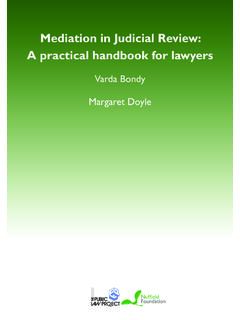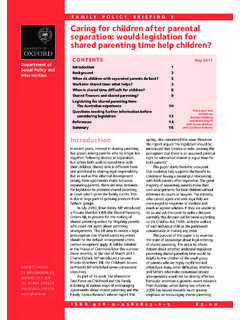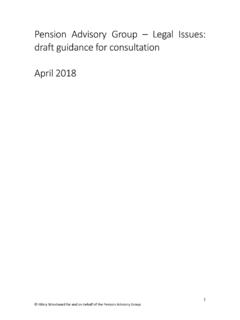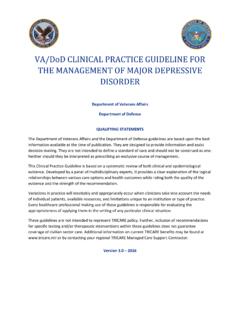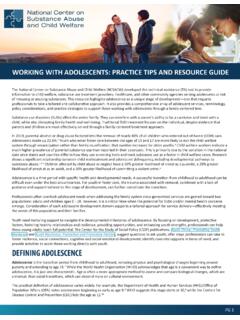Transcription of Heart rate, breathing rate, physical fitness – Student ...
1 Heart rate, breathing rate, physical fitness Student sheet 1 Nuffield Practical Work for Learning: Argumentation Heart rate, breathing rate, physical fitness Student sheet page 1 of 3 Nuffield Foundation 2013 downloaded from Personal record Record this information about the person who will be doing the exercise. a Would you describe yourself as physically fit? No (I exercise infrequently) Yes (I exercise frequently) Very (I take vigorous exercise ( cycling, swimming) frequently) b Measure the exerciser s pulse at rest (sitting down) for 15 seconds. Multiply the number of beats by 4 to get the Heart rate (beats per minute). Record this in the table below. c Measure the exerciser s breathing rate at rest for 15 seconds. Multiply the number of breaths by 4 to get the breathing rate (breaths per minute). Record this in the table below. d The person exercising should now begin to exercise (as directed by your teacher).
2 Start the stop clock. e After 4 minutes, stop exercising. Immediately, measure and record the Heart rate and breathing rate as before. f Take the Heart rate and breathing rate again at 2 minutes after exercise and 4 minutes after exercise. (If you have a pulse meter, you may be able to record pulse rate during exercise too, after 2 minutes, adding this to your table). Heart rate (beats per minute) At rest (During exercise) Immediately after exercise 2 min after exercise 4 min after exercise breathing rate (breaths per minute) At rest (During exercise) Immediately after exercise 2 min after exercise 4 min after exercise Extension: If you finish your data collection early, answer these questions. Will the combined class data be enough to evaluate any claim about fitness ? Are there any problems with method used to collect the data? Will these problems affect the validity of the data? Heart rate, breathing rate, physical fitness Student sheet 1 Nuffield Practical Work for Learning: Argumentation Heart rate, breathing rate, physical fitness Student sheet page 2 of 3 Nuffield Foundation 2013 downloaded from Answer these questions 1 Write down the claim you are evaluating.
3 2 Look at the evidence that you have collected as a class and work in a pair to discuss these questions. a Does the available evidence support the claim? b Can you explain how the evidence does or doesn t support the claim? c Do y ou have enough evidence to decide whether you agree or disagree with the claim? d If a claim is not supported by the available evidence what additional evidence you would need to support it? 3 Do you agree or disagree with the claim? Explain your answer. (Make sure you include the points you have just discussed) .. Heart rate, breathing rate, physical fitness Student sheet 1 Nuffield Practical Work for Learning: Argumentation Heart rate, breathing rate, physical fitness Student sheet page 3 of 3 Nuffield Foundation 2013 downloaded from Peer review Read the argument and decide whether it meets the success criteria. For each of the criteria use the comment box to say how well it has been met.
4 Do not just tick. Success criteria Comments (Not just ticking!) Is the claim clear? Is the claim linked to evidence? Does the evidence support the claim? If the data is not sufficient to support the claim, has it been suggested what other data would need to be collected? Are you convinced by the argument? How could the argument be improved? Heart rate, breathing rate, physical fitness Student sheet 2 Nuffield Practical Work for Learning: Argumentation Heart rate, breathing rate, physical fitness Student sheet page 1 of 3 Nuffield Foundation 2013 downloaded from Secondary data about Heart rate and exercise Scientists often look at data collected by other people to find out more about an area of science they are studying. Data you have collected yourself is called primary data. Data collected by other people is called secondary data. Your task is to: select one claim for your argument summarise your conclusions from each set of secondary data use the secondary data to evaluate your chosen claim use the primary data collected last lesson as additional evidence to support or reject the claim.
5 You need to think about whether there is enough data for you to be certain of the claim s accuracy. Claims 1 Men are more physically fit than women. 2 Walking does not affect breathing rate. 3 People who do more physical activity have a lower resting Heart rate. 4 Resting Heart rate decreases with age. Complete the argument frame at the end of this sheet once you have examined and summarised the secondary data. Secondary data Figure 1 1 The data in figure 1 .. A pair of students wanted to find out about the effect of exercise on Heart rate and breathing rate. They measured their Heart rate and breathing rate at rest, after walking up and down two flights of stairs, and after running up and down two flights of stairs. Here are the results. Heart rate breathing rate At rest (bpm) Walking (bpm) Running (bpm) At rest (breaths/min) Walking (breaths/min) Running (breaths/min) Student 1 68 63 112 12 12 16 Student 2 72 86 120 12 12 14 Heart rate, breathing rate, physical fitness Student sheet 2 Nuffield Practical Work for Learning: Argumentation Heart rate, breathing rate, physical fitness Student sheet page 2 of 3 Nuffield Foundation 2013 downloaded from Figure 2 2 The data in figure 2.
6 Figure 3 3 The data in figure 3 .. The resting Heart rates of 35 000 people in the US were measured. These graphs show how the average resting Heart rate varies with age. One line shows the data for females and one for males. US Department of Health and Human Services, National Health Statistics Reports No. 41, 24/8/2011. Seventeen adult men (ten young, and seven middle-aged) were studied in controlled conditions. At the start of the study they all did very little exercise. Their resting Heart rate was measured. They then took part in a three-month physical training programme. After three months their resting Heart rate was measured. Here are the results. Young men (average age 21) Middle-aged men (average age 53) Average resting Heart rate before physical training programme 69 bpm 72 bpm Average resting Heart rate after physical training programme 60 bpm 62 bpm Brazilian Journal of Medical and Biological Research (2002) 35: 741-752 Heart rate, breathing rate, physical fitness Student sheet 2 Nuffield Practical Work for Learning: Argumentation Heart rate, breathing rate, physical fitness Student sheet page 3 of 3 Nuffield Foundation 2013 downloaded from Argument frame Summary activity Use what you have learnt from these lessons to write a short paragraph explaining the effect of exercise on Heart and breathing rate.
7 Write down what you understand by fitness . Claim Evidence from secondary data and how this supports the claim Evidence from primary data and how this supports the claim Is the data sufficient to fully support the claim? Can you rewrite the claim so that it is fully supported by the data? Heart rate, breathing rate, physical fitness Teacher guidance Nuffield Practical Work for Learning: Argumentation Heart rate, breathing rate, physical fitness Teacher guidance page 1 of 9 Nuffield Foundation 2013 downloaded from Learning structure of the lesson The big picture This sequence of two lesson s is designed to exemplify an argumentation approach to practical work, using an analysing and interpreting data framework. Students use primary data about Heart rates and breathing rates, alongside secondary data from children and adults, to assess and argue for or against the validity of claims about physical fitness .
8 They consider whether the evidence is sufficient in itself to support the claims, particularly when the sample size is small, or whether more data is needed. They justify their decisions through argumentation. Age range: 14 16 Timing: 2 x 50 minutes 1: Learning episode 1 (teacher-led) 10 mins Show students how to find Heart rate and breathing rate. D iscuss what they think happens to Heart and breathing rate when you exercise and why. Introduce the learning outcomes for the lesson. Learning outcomes Students will be able to: Equipment and materials Teacher guidance Practical guidance Slide presentation Spreadsheet Student sheet 1 Student sheet 2 Per group Stopwatch or stopclock Per class Access to computer running Microsoft Excel to collate data and analyse it Refer to the health and safety advice and practical guidance 1: Learning episode 2 ( Student -led) 20 mins Assign students to groups and give each a claim to investigate.
9 Students carry out the practical activity and class data is collated on a spreadsheet. collect and analyse data about Heart rate, breathing rate, and self-assessed fitness level 1: Learning episode 3 ( Student -led) 20 mins Groups split into pairs and use the success criteria to evaluate their claim and develop an argument. Challenge students to justify their responses. Pairs swap arguments for peer assessment. decide whether evidence supports or does not support claims about physical fitness 2: Learning episode 4 (teacher-led) 10 mins Students reflect on what they learnt in lesson 1. Present the four claims which they will evaluate this lesson, using both primary and secondary data. 2: Learning episode 5 ( Student -led) 25 mins Each pair evaluates one or more of the claims. Some feedback to the class. Encourage others to ask questions, and challenge them to justify their arguments. Pairs write down their arguments and swap for peer assessment.
10 Decide whether evidence supports or does not support claims about physical fitness state what further evidence would be needed to support a claim 2: Learning episode 6 ( Student -led) 15 mins Class discussion drawing together ideas about fitness , validity of evidence, and strong scientific arguments. describe the effect of exercise on Heart rate and breathing rate Key words Argument, claim, evidence/data, correlation Heart rate, breathing rate, physical fitness Teacher guidance Nuffield Practical Work for Learning: Argumentation Heart rate, breathing rate, physical fitness Teacher guidance page 2 of 9 Nuffield Foundation 2013 downloaded from Prior knowledge It is assumed that students know the following. How to interpret line graphs and tables of data. The Heart pumps blood around the body, and blood provides tissues with oxygen and glucose needed for cellular respiration. Respiration provides energy to the tissues for activity such as muscle contraction.

